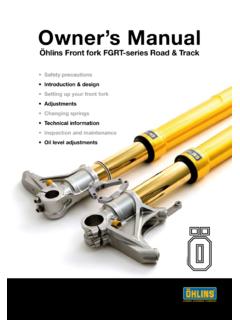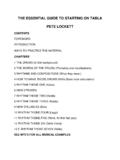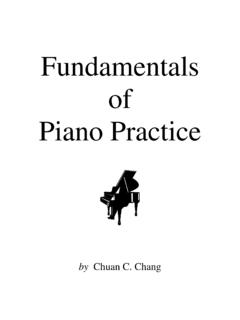Transcription of Understanding your Dampers: A guide from Jim Kasprzak ...
1 Page 1 of 25 Understanding your dampers : a guide from Jim Kasprzak Introduction I believe dampers are the most misunderstood components on a race car. In fact in the they are often called shock absorbers, even though they really don t absorb shock! Even the well know race car engineer Carroll Smith remarked, Sometimes I think that I would have enjoyed racing more in the days of friction shocks. Since you couldn t do anything much to them or with them, I would have spent a lot less time being confused. It is thought by many that dampers are a black art, and that there is some magic to developing and tuning dampers .
2 I am here to dispel those myths, and provide you information and tools to develop dampers for FSAE cars. There is art to damper development and tuning. The art is using engineering knowledge and tools to optimize your car s dampers . Since you are college students, you probably don t have time to read this whole section of the book. However, there is a lot of valuable information contained in each part. If you decide to skim this chapter, be sure to read the following: Gas pressure Proper Suspension Design Damping force calculations Damper Fit Check Handling The Care and Feeding of your dampers A Shock Absorber is a Damper A shock absorber damps the motion of both the sprung and unsprung masses of the car.
3 The sprung mass is the body and chassis of the car, and everything supported by the springs. The unsprung mass is composed of all the components not supported by the springs. This includes the suspension upright and all components attached to it; the brake caliper, brake disc, wheel, tire and a portion of the suspension arms. Figure 1 Although there is a small amount of damping in the tire (approximately 2%) the suspension damper must do the majority of the damping for this whole system. That means damping the sprung mass, unsprung mass and the tire! While springs and sway bars produce force based on their displacement or deflection, dampers produce force based on how fast you move them, or their velocity.
4 Therefore, the amount of damping produced is proportional to velocity. This means the damper works like a dynamic spring; it produces force only when it is moving. Page 2 of 25 The primary function of the damper on the vehicle is to damp the sprung and unsprung masses at their resonant frequencies. For the sprung mass, this includes the pitch, heave and roll resonant frequencies. A secondary function is to control the rate of weight transfer during transients such as braking, corner entry and acceleration. In the best case, dampers are The frosting on the cake. If everything else in the suspension design and component selection is correct they simply damp the vibrations at resonant frequencies, control the rate of weight transfer and enhance vehicle comfort and performance.
5 In the worst case dampers Hold the cake together! They are asked to compensate for structural deficiencies, control heave, pitch or roll imbalances, and compensate for design deficiencies like lack of suspension travel. How Much Damping? The suspension on a FSAE car is two spring/mass/damper systems in series (see Figure 1). The first consists of the suspension spring, body/chassis mass (sprung mass) and the damper. The second consists of the tire (as the spring), suspension parts (unsprung mass) and the little bit of tire damping. Figure 1 shows the system for a single corner of the car. Remember, there are FOUR of these systems on your car.
6 This means the dampers must damp the 16+ degrees of freedom of the car!!! However, for simplicity, we will deal with the primary vibrations of the vehicle; heave, pitch and roll of the sprung mass, and unsprung resonance. First and foremost you must get these under control. Once you do that, the rest is tuning to optimize performance. So how much damping do you want? Just enough! Any more reduces grip, increases tire force variation and tire wear, and makes the ride worse. What we want is the correct amount of damping. Overdamping or underdamping increases the variation of tire force to the track, reducing tire adhesion or grip.
7 Most text books state the proper damping ratios are This is appropriate for passenger cars, but not enough for FSAE and other race vehicles with higher spring and tire rates, and thus, higher natural frequencies. As a rule of thumb, a FSAE car will require a damping ratio of to control the heave, pitch and roll resonances of the sprung mass, and a damping ratio of to control the unsprung mass. But this is NOT the entire answer, so keep reading! Damper Construction Before we get into damping force calculations let s examine the basic elements of a damper, compare the three basic types of damper construction and look at the advantages and disadvantages of each.
8 Elements of a damper (See Figure 2) Main piston: In all dampers the main piston contains the primary valving components and produces the majority of the damping forces. In all three constructions, all the rebound force is produced by the Main Piston. Compression Piston: The Compression Piston has several functions: o Produces compression force based on the rod displacement through the Compression Piston. This results in lower compression pressures for the same damping force, typically resulting in less tire force variation and better grip. o Provides a pressure balance to the main piston during the compression stroke to prevent cavitation.
9 This enables dampers with Compression Pistons to operate with lower gas pressure. Note that the Monotube damper does not have a Compression Piston. Gas Separator Piston: Keeps the gas separated from the oil. Main Piston Tube: This is the tube where the Main Piston operates. Note in the Monotube damper it is also the outer tube. Reservoir Tube: The Reservoir Tube is the outer tube on a Twin Tube damper and creates the area for extra oil and the gas pressure in a Twin Tube shock. Page 3 of 25 Figure 2 Advantages and Disadvantages of Each Construction Twin Tube Advantages o Inexpensive o Compression Piston.
10 This means lower compression pressures and typically lower gas pressure can be used. Disadvantages o Has to be mounted rod up to avoid cavitation o No Gas Separator Piston to separate the gas from the oil. This can result in the gas and the oil mixing, reducing damping forces. o Smaller piston diameter for a given outer tube diameter. The result is higher operating pressures and more fade. Monotube (no Compression Piston) Advantages o Oil is separated from the gas. o Higher quality construction than most Twin Tube shocks Disadvantages o No Compression Piston. This means higher gas pressure to prevent cavitation.





